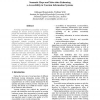Free Online Productivity Tools
i2Speak
i2Symbol
i2OCR
iTex2Img
iWeb2Print
iWeb2Shot
i2Type
iPdf2Split
iPdf2Merge
i2Bopomofo
i2Arabic
i2Style
i2Image
i2PDF
iLatex2Rtf
Sci2ools
DEXAW
2005
IEEE
2005
IEEE
Semantic Maps and Meta-data Enhancing e-Accessibility in Tourism Information Systems
Providing comprehensive accessibility is the major challenge for tourism service providers to address people with disabilities (and older people) as growing consumer groups. Information about accessibility of tourism objects (accommodation, sights, streets, parks, etc.) is equally important as barrier-free tourism information systems, providing access through different mediums, to support the booking and decision making process. Consequently, this paper introduces the extension of tourism information systems in a twofold way. First, each tourism object is provided with information about its accessibility realized by additional meta-data information. Second, based on both medium profiles and user profiles content presentation and user interface navigation are dynamically adapted to the user's individual needs in order to support appropriate search as well as presentation features. Additionally, it presents the concept of multi-layer semantic maps to illustrate relevant factors in ...
| Added | 24 Jun 2010 |
| Updated | 24 Jun 2010 |
| Type | Conference |
| Year | 2005 |
| Where | DEXAW |
| Authors | Hildegard Rumetshofer, Wolfram Wöß |
Comments (0)

